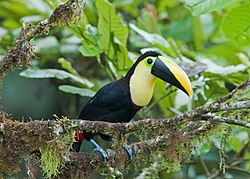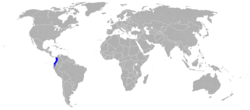| Choco toucan | |
|---|---|
 | |
| Scientific classification | |
| Kingdom: | Animalia |
| Phylum: | Chordata |
| Class: | Aves |
| Order: | Piciformes |
| Family: | Ramphastidae |
| Genus: | Ramphastos |
| Species: | R. brevis |
| Binomial name | |
| Ramphastos brevis Meyer de Schauensee, 1945 | |
 | |
| Estimated Choco toucan range in blue | |
| Synonyms | |
| |
The Choco toucan (Ramphastos brevis) is a near-passerine bird in the family Ramphastidae, the toucans, toucanets, and aracaris. It is found in Colombia and Ecuador. [2]


